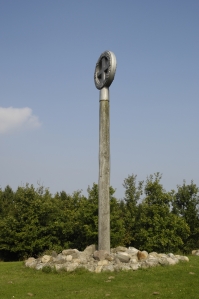The North Star is not a particularly bright star; it doesn’t make the top 20. It’s no. 45, actually. What’s even more disturbing is that it hasn’t always been the pole star, and it will eventually move out of position again. The Earth’s orbit has a wobble in it, and thus the north pole rolls around a little over the course of the millennia.
Imagine the poles as the ends of the dowel sticking out of a round top, and you can imagine the north end wobbling around as the top rolls. This is a bit of a blow to myths about the north star, because they tend to stress the constancy and centrality of Polaris.  So when the Egyptians were building the pyramids, the star Thuban in the constellation Draco (Dragon) was the pole star. Then the earth’s wobble moved the north pole closer and closer to Polaris, until it will center right on it in about 2100. After that it will start to move toward the star Vega in Lyra. Then we begin again.
So when the Egyptians were building the pyramids, the star Thuban in the constellation Draco (Dragon) was the pole star. Then the earth’s wobble moved the north pole closer and closer to Polaris, until it will center right on it in about 2100. After that it will start to move toward the star Vega in Lyra. Then we begin again.
The name Polaris, by the way, comes from Latin stella polaris (“pole star”), Another name for it was the Greek cynosura, dog’s tail, because they saw Ursa Minor as a dog rather than a bear, plow or dipper. Ironically, the English form cynosure now means center, as in the center of all eyes, because the circumpolar stars rotate around the North Pole.
To the Norse the north star was the nail star, the spike through the heavens around which everything pivoted. They associated it with the god Tyr (German Tiw). As the Anglo-Saxon rune poem says:
Tiw is a guiding star; well does it keep faith with princes;
it is ever on its course over the mists of night and never fails.
The Germans had a great pillar they called Iriminsul, destroyed by Charlemagne during his conquest of the pagan Saxons. As part of a cult of poles and pillars, it could stand for the world-pillar, with Polaris at the top. (The Chukchee of Siberia called it Unp-e-ner, “the pole-stuck-star”. Another Siberian people, the Koryak, called it the nail in the sky.)
Celtic lore is a little harder to come by, but Polaris could be the centre of Caer Sidi, the Revolving Wheel. The Welsh goddess Arianrhod lived there with her attendants. Her constellation is probably the Corona Borealis, which revolves around the north star. This would be her own dwelling, Caer Arianrhod.
The north star was often called the navigator’s star, because its lack of movement made it a point to take one’s bearings from. The Greeks began using it after the early mathematician and astronomer Thales of Miletus noticed its usefulness, along with many other peoples, including the Phoenicians, who had been navigating with it since 1100 BCE.
Despite its association with the north, most of the Inuit did not use Polaris as a navigation aid, because they were too far north for it to be useful to them. (It gets lower in the sky the farther north you go.)
 At the South Pole, incidentally, there is no very bright star at this time.
At the South Pole, incidentally, there is no very bright star at this time.
The constellation closest to it is Octans, representing a sailor’s octant, which navigators used before sextants became available. Sigma Octanis is the closest to the pole. You can see this star without any aids, but it isn’t very bright, at 5.5 magnitude. (Polaris is 2.0 magnitude. Smaller is better; 1.0 is best.) It is sometimes known as Polaris Australis.
The bright star Canopus was used as a sort of south pole by the ancient Greeks and Egyptians, as it is much easier to see.
PS – I couldn’t leave this topic without noting that there is a Marvel superheroine called Polaris. Her powers are mainly magnetic, like Magneto’s, and she wears a vivid green outfit to match her green hair. The Kirby Krackle tones nicely.
And if you like the image at the top, click here.



Pingback: Arianrhod: Silver Wheel – We Are Star Stuff
Pingback: Sirona: the star goddess |
Pingback: Vega: the jewel in the Harp – WE ARE STAR STUFF
Pingback: Astraios: Father of the Stars – We Are Star Stuff
Pingback: Spica: the Wheat Sheaf – We Are Star Stuff